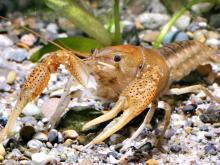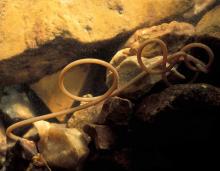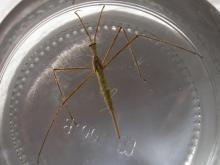Aquatic Invertebrates
Media

Species Types
Scientific Name
Procambarus acutus
Description
Adult White River crawfish are usually a deep burgundy red with a black V-shaped stripe on the abdomen. Juveniles are gray with dark spots scattered over the carapace. In Missouri, this species mostly occurs in the Bootheel and north along the Mississippi River.
Media

Species Types
Scientific Name
Procambarus clarkii
Description
Adult red swamp crawfish are dark red (nearly black on the carapace) and have a wedge-shaped black stripe on the abdomen. Juveniles are a uniform gray, sometimes overlain by dark wavy lines. In Missouri it lives in the Bootheel.
Media

Species Types
Scientific Name
Ligumia subrostrata
Description
This widespread species is one of the few Missouri mussels successful in shallow ponds and lakes.
Media

Species Types
Scientific Name
Potamilus purpuratus
Description
Like the pink heelsplitter and fragile and pink papershells, the bluefer uses freshwater drum as a host.
Media

Species Types
Scientific Name
Bivalve molluscs in order Unionoida
Description
Secretive and seldom seen, freshwater mussels are extraordinarily diverse in Missouri. We have nearly 70 species within our borders. Many are declining, and several are endangered.
Media

Species Types
Scientific Name
Various species in the subclass Hirudinea
Description
Most people are repulsed by leeches. But once you get past the fact that many species are parasitic bloodsuckers, you will discover that they are fascinating creatures with an important role in nature.
Media

Species Types
Scientific Name
Freshwater species in the phylum Bryozoa
Description
Bryozoans are tiny, filter-feeding invertebrates. They create colonies that can be mossy, branching, or round and jellylike.
Media

Species Types
Scientific Name
About 350 species scientifically described.
Description
Adult horsehair worms can be nearly 3 feet long and live in water. They are practically featureless, smooth, aquatic worms that writhe into knots and curls.
Media

Species Types
Scientific Name
Ranatra spp. and Nepa apiculata
Description
Water scorpions remain still, looking like a random bit of plant material. Then they suddenly grab their prey and deliver disabling fluids with a quick jab of their knifelike beak.
Media

Species Types
Scientific Name
Dugesia, Planaria, and other genera
Description
Unlike their parasitic cousins in the flatworm group, turbellarians, or planarians, are tiny carnivores or detritus-eaters that glide smoothly across submerged leaves and other objects.
See Also
About Aquatic Invertebrates in Missouri
Missouri's streams, lakes, and other aquatic habitats hold thousands of kinds of invertebrates — worms, freshwater mussels, snails, crayfish, insects, and other animals without backbones. These creatures are vital links in the aquatic food chain, and their presence and numbers tell us a lot about water quality.





















